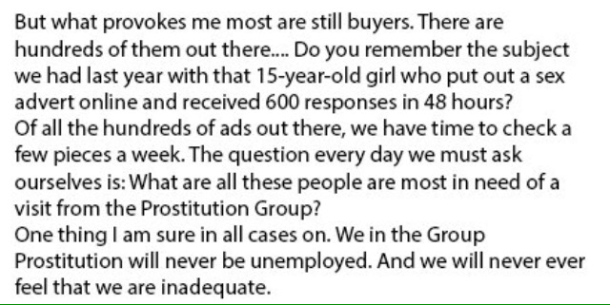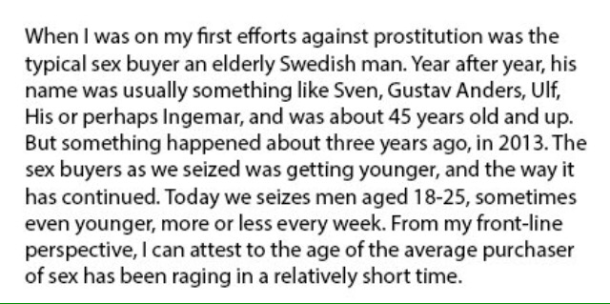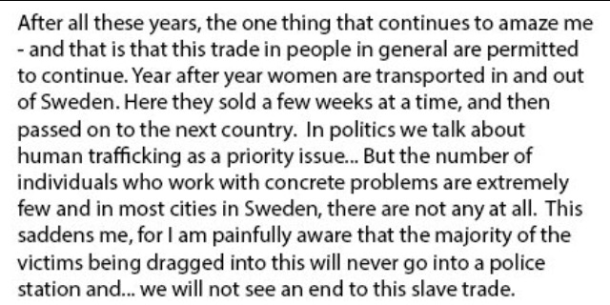I’ve commented several times that what the Swedes say internally about their sex industry is often very different to the impression they give abroad, when trying to export the sex purchase ban. This is a good recent(ish) example, a press statement from their police service website – only issued in Swedish – which, run through Google Translate, reveals something interesting about police knowledge of the sex trade:
Most of the sex trade [is] currently conducted via the internet. None of the inspecting authorities have a complete picture of the scope as they are not engaged in continuous or structured reconnaissance.*
It’s an interesting contrast with the claims we normally hear from the Swedes, which exude absolute confidence and certainty that their sex industry has declined since clients were criminalised. Self-evidently, if you aren’t monitoring something in a consistent and coherent fashion, you can’t reach a definitive conclusion as to whether or not it has declined.
The police do monitor the sex industry to some degree, of course, and their findings are included every year in a document titled Trafficking in human beings for sexual and other purposes. The English version of the latest report was published last May, and covers the year 2011. While that makes it slightly out of date at this point, it’s still more than a decade after the sex purchase ban was introduced, and therefore useful in helping to determine whether the law’s objectives really have been met.
Section 3.1 covers “Trafficking in human beings for sexual purposes”, and it starts off by hedging the statistics with the following disclaimer:
According to the Swedish National Police Board it is difficult to estimate how many people fell victim to human trafficking in Sweden during 2011. The number of victims of human trafficking identified in Sweden largely depends on the resources which the police put into detecting this crime and on the experience and competence that exists within the police organisation. The level of these initiatives varies between police authorities and can vary from one year to another. It is not possible to identify or even to locate all of the victims, mainly girls and women, mentioned in tapped telephone calls or observed during police surveillance.
There’d be nothing remarkable about this paragraph, were it not for the fact that it entirely contradicts one of the lines the Swedes often use when trying to sell the sex purchase ban abroad: “if the customers could find these persons, we could find them”. That line is intended to refute the suggestion that the sex industry has merely gone underground; but the text quoted above (and similar elsewhere in this report) is an open admission that some of it is underground and will probably remain there. And this, bear in mind, refers only to those believed to be victims of trafficking; if they admittedly can’t estimate those numbers, it’s hardly possible they could estimate the numbers of people selling sex through choice or circumstance, who (one hopes) they aren’t expending as much of their resources to find.
While the report quite rightly attributes some of the increase in numbers to better investigative work, it also indicates a belief that at least some of the increase represents more actual cases. For example, describing an apparent rise in the number of “women from Lithuania who are being exploited in prostitution in Sweden”, the report says:
Changes in the victims’ backgrounds and nationalities can be explained by a weakened national socio-economic climate which is hitting women and girls particularly badly. The economic crisis in southern Europe may also mean that human traffickers and pimps are directing their activities towards countries with more stable economies, such as Sweden.
These two statements may seem somewhat at odds with each other – the first suggests that the numbers are increasing because Sweden’s economy is getting worse [ETA – see comments below from Laura Agustín], while the second suggests that it’s because Sweden’s economy is relatively stable – but the important points are this: first, the tacit acknowledgment (made explicit later in the report) that there has been an increase at all; and second, the admission that Sweden remains attractive to “human traffickers and pimps”, which is totally contrary to the propaganda we hear about it all. the. time.
A genuine jaw-dropper follows a few paragraphs later:
In 2009, the National Bureau of Investigation estimated that there were about 90 Thai massage parlours in Stockholm and vicinity, most of which were judged to be offering sexual services for sale. At the turn of 2011/2012, the number of Thai massage parlours in the Stockholm area was estimated to be about 250 and throughout the country about 450.
Now, what kind of “successful ban” leads to an almost threefold increase in one type of provider of the banned thing in less than three years? If the estimate is accurate, this statistic alone ought to put paid to any claim that the law is an effective deterrent. An industry that has lost a lot of its customers couldn’t possibly expand at a rate like that. (See previous post on this topic here.)
The report goes on to shed an interesting light on the Swedish view of sex workers who choose their occupation – in particular, those who aren’t from Sweden. It states:
In February 2011, the police authority in the county of Halland decided to deport a Romanian woman … . Police authorities said that the woman, who made her living through prostitution, constituted a threat to public order and security. The woman appealed to the Swedish Migration Board who made the same assessment as the police authority in Halland: namely that prostitution is indeed legal in Sweden, but the purchase of sexual services is a criminal offence. This means in practice that a crime has to be committed under Swedish law to enable a person engaged in prostitution to support themselves.
This decision was ultimately thrown out in court as a breach of EU freedom of movement, but subsequently the Justice Ombudsman, considering the case of another EU sex worker, upheld the Migration Board’s position:
“…prostitution is to be regarded as a dishonest means of support according to the law. Prostitution – which can not occur without a crime having been committed – may also be considered as a prohibited occurrence in one principal element. Unlike the judgement in a previous determination by the Ombudsman for Justice, which related to begging, deportation in this case is considered to be compatible with the Aliens Act.”
This demonstrates a point which is well-made by Norwegian criminologist May-Len Skilbrei here: just because it isn’t a crime to sell sex doesn’t mean a person can do so without facing the strong arm of the law. If the State makes it a policy that sex work is something that cannot be tolerated, its officers will fight it with whatever means they have at their disposal: immigration laws, housing laws (as in Norway’s notorious “Operation Homeless”), public order laws (same link; see also the French bill which explicitly allows such laws to be used against street workers); Anti-Social Behaviour Orders (the reversal of which was deemed “frustrating” by a Swedish model-supporting Irish parliamentarian), custody laws (with tragic consequences last year) and probably anything else you can think of, short of actually prohibiting the sale of sexual services. And these have a similar effect as prohibiting the sale of sexual services, namely, giving sex workers an incentive to avoid state officials or anyone they think might rat them out to state officials (including the police and health and social services). In this context, the distinction between the Swedish model and one which directly criminalises the sale of sex is a distinction without all that much of a difference.
Getting back to the report, it goes on to describe in some detail the awful conditions and abuse that many migrant sex workers endure. I won’t quote it here, but suffice to say it’s on a par with any of the tragedy porn regularly cited in support of the Swedish model. It describes the significant involvement of organised crime in the sex industry, another of the things we in Ireland are frequently told we need the Swedish model to address. And it also goes on to describe a Swedish “review” site which could easily have been used as a source on that Invisible Men tumblr (which, of course, also propagandises for the Swedish model). These are other ways in which the sex purchase ban seems to have fallen short of the grandiose claims made for it.
The report then confirms something sex workers themselves have complained of:
In 2011, the police Prostitution Team in Stockholm established that the sex-purchasers seemed to prefer to use “out-calls” to a greater extent than before. One reason for this is believed to be that the sex-purchasers consider that the risk of detection will be less if they order a woman to come to their home instead of exploiting her in a hotel room.
Here, the report directly contradicts one of the findings of the 2010 official evaluation, namely, that sex workers are not at greater risk of violence under the law.
Section 3.1 concludes with a couple pages on “Payment for sexual services”. Here, the report briefly discusses the law against buying sex, the statistics on the offence and the (positive) conclusions of the official evaluation (which it quotes without comment). Notably absent is a claim that appeared in previous years’ reports that the law deters traffickers from setting up business in Sweden. Perhaps the Swedish police no longer believe they can stand over this claim. It’s not hard to see why.
**
Last month, I took part in a debate with Sarah Benson from Ruhama and Nusha Yunkova from the Immigrant Council of Ireland – the two NGOs leading the Turn Off the Red Light campaign. (Kathryn McGarry, a researcher from NUI Maynooth, made up the balance on the panel.) In response to my citing this report, Sarah Benson said that the Swedes “never said” they would eliminate prostitution entirely. I don’t think this is strictly true; the Swedish Women’s Lobby, for example, has described the law as “a model to end prostitution and trafficking for sexual exploitation”.
But it’s certainly the case that the law has been promoted outside of Sweden – not least in Ireland – as one that has been a hell of a lot more effective than this report shows it to be. In fact, when interviewed by the Irish community TV programme The Live Register, Nusha Yunkova made the amazing claim that “there is no prostitution in Sweden”. While this would stretch credulity of even the most gullible Irish politician, I think it’s fair to say that most of those who’ve declared their support for the Swedish model would be surprised by the contents of this report. They’ve been sold a law that has been “proven” to reduce the size of the sex industry, not one that isn’t actually being measured in this respect. A law that “reduces” sex trafficking from other countries, not one under which the number of women from certain countries “who are being exploited in prostitution in Sweden” has increased. A law that “deters” men from purchasing sex, not one that is such a useless deterrent the number of massage parlours in the capital has almost trebled in recent years. And so on.
Of course, knowing the considerably less rosy reality of the Swedish model probably wouldn’t make a difference to the average politician or those leading the TORL campaign; facts and evidence aren’t really their main concern. But at least they couldn’t cloak their moral, ideological and populist stances under a veneer of empiricism. For those whose support for the law stems from a sincere belief that it’s actually had a significant effect on deterring clients and reducing the extent of sex work and trafficking, they’re entitled to hear the evidence that it hasn’t. And we’re all entitled to an honest debate – something that’s been sorely lacking in Ireland so far.
*ETA: The statement has now been removed from the Swedish police website. The original Swedish text was: “Merparten av sexhandeln bedrivs numera via internet. Ingen av de inspekterade myndigheterna har dock någon fullständig bild av omfattningen eftersom de inte bedriver någon kontinuerlig eller strukturerad spaning på nätet”.

















